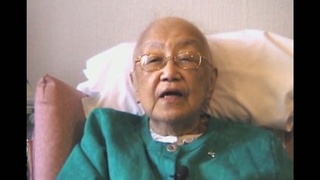Interviews
The reason for coming to Japan
The reason why I came to Japan was because I had an offer to play racquetball, which was my former sport at the time. I was a racquetball player—me and my brother. They wanted my brother to come, but because he was one of the top players, pro racquetball players in the pro tour, he was busy. So they kind of went down to the younger brother. “Oh, what about Enson?” And I was here. I had no idea what Japan was about. I couldn’t even imagine what the country was like. I really thought it was—I understood it was my roots, but I actually thought it was some weird place where people don’t speak the language. All Nikkei, all Japanese people there—I felt kind of weird. But I thought if you experience the culture, it would be a good trip. So, actually, the reason why I came out here was for a two-week racquetball tournament.
Date: October 14, 2003
Location: Saitama, Japan
Interviewer: Art Nomura
Contributed by: Art Nomura, Finding Home.
Explore More Videos

Mother's immigration to U.S. as a treaty merchant
(b. 1927) Japanese American Nisei. Family voluntarily returned to Japan during WWII.

Living in Japan during the war, preparing for U.S. bombings
(b. 1927) Japanese American Nisei. Family voluntarily returned to Japan during WWII.

Participating in military drills in school in Japan during the war
(b. 1927) Japanese American Nisei. Family voluntarily returned to Japan during WWII.

Hearing anti-American war propaganda from a teacher
(b. 1927) Japanese American Nisei. Family voluntarily returned to Japan during WWII.

The hardships of life in Japan during World War II
(b. 1927) Japanese American Nisei. Family voluntarily returned to Japan during WWII.

Why her parents came to Canada
(1918-2004) Interned in Slocan during World War II. Active member of the Japanese Canadian community.

Family background of Fredrick Yoshihide Sasaki
(b. 1918) Issei businessman in Canada

Arranged marriage
(b.1912) Japanese Canadian Issei. Immigrated with husband to Canada in 1931

Her early life in Canada
(b.1912) Japanese Canadian Issei. Immigrated with husband to Canada in 1931

Chose to go back to Japan
(b.1924) Japanese Canadian Nisei. Interpreter for British Army in Japan after WWII. Active in Japanese Canadian community

Strict school policy of separating boys and girls in Japan
(b.1920) Japanese Canadian Nisei. Established the Ikenobo Ikebana Society of Toronto

Choice to move east or go to Japan
(b.1920) Japanese Canadian Nisei. Established the Ikenobo Ikebana Society of Toronto

Coming to America
(b.1943) Shin-issei grand master of taiko; founded San Francisco Taiko Dojo in 1968.

Yobiyose system in Canada
(b. 1922) Canadian Nisei who was unable to return to Canada from Japan until 1952

Reason to come back to Canada in 1954
(b. 1922) Canadian Nisei who was unable to return to Canada from Japan until 1952
